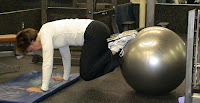If I were to ask you, what one part of the body would you most like to change? Chances are it might be your lower abdominal area. It’s been my experience that almost everyone would like to get a sexy, flat-as-a-plank abdomen. But it can often be one of the most difficult parts of the body to develop.
One reason is that lower abdominal exercises require more concentration and muscle control than many other exercises. As a result, many people end up cheating by using their hip flexors or lower back muscles and denying the lower abdominals the specific work needed to strengthen and develop.
In addition, people frequently attempt to perform lower abdominal exercises that are too difficult for their ability level so they do not use the correct muscles while performing the exercise.
To avoid these common mistakes, here are a few tips to keep in mind while performing lower abdominal exercises:
1. Execute the exercises slowly, with control. Performing the exercises too quickly will cause you to minimize the effectiveness of the exercises.
2. You should feel your lower abdominals working during the exercise. If you don’t feel the lower abdominals working then you are no longer targeting those muscles effectively.
3. And, you should not feel pain in your lower back. If you feel pain in your lower back, either your lower abdominals are not strong enough for that exercise or you’re not doing the exercise correctly.
Lower Back Flatten. You must be able to perform this exercise and hold the contraction before you can safely attempt the more advanced movements.
Start by lying on your back with your knees bent and your feet flat on the floor. There should be a small space under your lower back from the natural curve in your spine.
Then activate your lower abdominals to flatten your lower back until you feel your back pressed against the floor. Some pelvic rotation will occur for the back to completely flatten, but make sure to use the abdominal muscles to create this motion. The legs should stay as relaxed as possible during the exercise.
 Double Leg Lowering. There are four different difficulty levels to this exercise: knees bent to 45 degrees, knees bent to 90 degrees (illustrated in the photo), knees bent to 130 degrees and knees fully extended. Basically, as you extend your knees, you increase the demand on the lower abdominal muscles.
Double Leg Lowering. There are four different difficulty levels to this exercise: knees bent to 45 degrees, knees bent to 90 degrees (illustrated in the photo), knees bent to 130 degrees and knees fully extended. Basically, as you extend your knees, you increase the demand on the lower abdominal muscles.
Lie down on your back, with your hands placed under your butt, and your palms facing the floor. Then contracting your lower abdominal muscles to flatten your back against the floor, lift your legs up vertically until your thighs are perpendicular to the floor. Lower your legs until they almost touch the floor, then raise your legs back to the starting position and repeat.
 Prone Bridge. There are three different levels to this exercise and the version illustrated in the photo is the most advanced.
Prone Bridge. There are three different levels to this exercise and the version illustrated in the photo is the most advanced.
Lie face down on the ground or floor and stretch out in a prone position. Then lift your body up so that you’re balanced only on your forearms and toes. Now tuck your butt. This means rotating the lower part of your pelvis toward the ground. Then hold this position for 30 seconds and rest.
To increase the difficulty, get into the position where you’re balanced on your forearms and toes with butt tucked. Then raise one leg and hold for 30 seconds. Repeat on the other side for 30 seconds and rest.
To advance this exercise one step further, get into the position where you’re balanced on your forearms and toes with butt tucked. Then raise opposite arm and leg, simultaneously, (as illustrated in the photo) and hold for 30 seconds. Repeat on the other side for 30 seconds and rest.
 Swiss Ball Prone Jackknife. Start by getting into a pushup position with the tops of your feet on a Swiss ball. Your body should form a straight line from your toes to your shoulders with your hands positioned just slightly wider than your shoulders.
Swiss Ball Prone Jackknife. Start by getting into a pushup position with the tops of your feet on a Swiss ball. Your body should form a straight line from your toes to your shoulders with your hands positioned just slightly wider than your shoulders.
 Keeping your back flat and abs tight, bend your knees and roll the ball toward your torso. Squeeze your abs for a second and then roll the ball back to the starting position and repeat. Keep the movement smooth and be sure to keep your spine in a neutral position.
Keeping your back flat and abs tight, bend your knees and roll the ball toward your torso. Squeeze your abs for a second and then roll the ball back to the starting position and repeat. Keep the movement smooth and be sure to keep your spine in a neutral position.
If performed correctly, these exercises will build a solid foundation of lower abdominal strength which will have the effect of tightening and flattening your abdominal wall. They will also improve spinal stability and prevent lower back problems. Of course, your nutritional habits will have the greatest impact on how your abdominals look.
